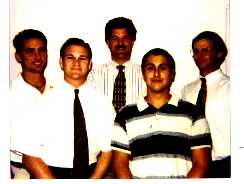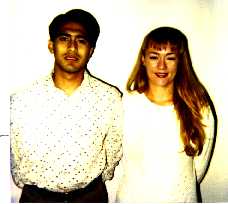Aquatic Exercise Program as an
Effective Alternative Method of Cross Training for Cross Country and Track Athlete
By Michael Mandas, P.T.; Andrew R. Einhorn, P.T.
C.S.M.T.; Jon Ellertson, B.S., P.T.A.; Shawn Hickling, B.S. Exercise Physiology; Kirsten
Pieters, B.S., Athletic Training; Michael Quinn; Gilbert Orbeso
of Los Alamitos Orthopaedic & Sports Physical
Therapy
 
PART II
Below is a list of some typical track-related exercises that can be
used for both aerobic (endurance) and anaerobic (power) training.
Deep Water Exercises
The following exercises are to be performed in a vertical position with
the abdominal musculature contracted to help stabilize the spine. Maintaining the three
natural curves of the spine begins at the head. Alternating concave-convex curvatures
begins at cervical spine and progresses to the lumbar spine. Maintaining proper head
position with the chin tucked shoulders retracted and the abdominal muscles taught to help
avoid lumbar hyperextension.
High Knees
Alternate hip and knee flexion on one side and hip and knee extension
on the other. In each deep water exercise the athlete is shown using hydro-fit dumbells
(buoyancy assistive devices) in each hand and hydro-fit cutoffs (buoyancy assistive and
resistive devices around ankles). These devices are optional. Exercise can also be
conducted in a corner section of the pool as the athlete holds the top pool copping
section for support. Pool side bars can also be used for upper body support during lower
extremity exercise.
Cross Country Ski (CC Ski)
Alternate hip flexion and extension while keeping the arms and legs
straight.
Half Jack
Simultaneous hip flexion with knee extension and hip extension with
knee extension.
Jogging
Simulation of jogging on land performed in the water. See description
of running.
Running
Running in deep water is performed with the in a 5 degree forward tilt.
This bend should occur at the hips, nor from the spine. The biomechanical movement patter
of water running resembles that used on land. (3) Running in water requires the following
techiques:
- A) The head is held comfortably out of the water, facing forward; avoid
the forward head ad shoulder posturing.
- B) Maintain a neutral spine as previously described.
- C) The arm action is the same as for land running, with the primary
movement occurring at the shoulder and with the hands relaxed but lightly closed. (3)
- D) Hip flexion should reach approximately 60-80 degrees at the same time
the knees flex or extend. (3)
- E) Ankle movements should include both dori and plantar flexion.
Scissors
Start with hip and knee extension bilaterally. Adduct both legs, one in
front the other behind, followed by, adbuction and adduction but the rear leg is now in
front and the front is now behind.
Knee Extension
Place thigh buoy between inner thighs just above the knee joint. Keep
thighs together while simultaneously alternating knee flexion on one leg and knee
extension on contralateral knee.
Shallow Water Exercises
Double Leg Hopping/Single Leg Hopping
(Forwards-Backwards-Side to Side with feet together). Shown below is
side to side hopping. Hydro-fit cuffs (buoyancy assistive and resistive devices around
ankles). These devices are optional.
Shallow hops, directly upward, with only slight knee bend upon impact.
Emphasize a proper lower extremity alignment. Keep the patella over the big toe during all
movements. The quadriceps femoris muscles will control patellofemoral alignment if
excessive valgus-varus posturing is avoided.
High Knees
Exaggerated walking, performed by full flexion of hip and knee while
other leg remains fixed on pool bottom.
Skateboarding (6)
Performed with one leg fixed on the edge of a step while the other leg
simulates the propulsion phase of skateboarding. The leg on the step slightly bends with
the "toe touch" part of this exercise.
Split Jumps
Alternating lunges performed at a high intensity by jumping out of the
lunge and alternating the lead leg.
Step Jumps-Double Leg
Double Leg jump upwards, onto a step, followed by a backwards
"hop" off the step.
Jump Squats
Legs shoulder width apart. Start in a semi-squat position, followed by
a forceful jump upwards and only a slight knee bend upon impact.
Speed Skaters
Alternating sideways hopping on one leg. Similar to the motion
performed by an ice skater.
Split Jumps on Step
Similar to split jump only the lunge is performed on a step.
Skier Side Jumps
Double leg side hopping performed in a side-to-side or diagonal motion.
Karioka
Sideways walking or jogging only lead leg alternates between each step.
Hopping Single Leg
Same as hopping described previously, only performed on one leg.
North/South/East/West
Instructor cues athlete on spontaneous change of direction on any given
exercise, mostly running.
Deceleration Jump Squats
Begin with the legs shoulder-width apart and slightly bent. Jump
upwards and absorb the impact of the landing by performing a moderate bend at knees.
WALL CONDITIONING
Burpees
Arms remain fixed at poolside while athlete performs full body
extension away from poolside, followed by full body flexion toward poolside. Same as
traditional physical education exercise only performed in deep water.
Crunches
The athlete starts in a vertical position and then proceeds to
"curl" lower body up toward the water surface and returns to the vertical
position. Emphasize a neutral spine position.
BALANCE AND PROPRIOCEPTION
Deep H20 Wonderboard Squatting
Athlete attempts standing on wonderboard while simultaneously
performing deep leg squats.
SLIPS (7) = Single Leg Integrated Proprioception Skills
- A) Single Leg Balance -- Balance on one leg with minimal body movement.
- B) SLIPS with Leg Swing--While standing on involved leg, combine
contralateral hip flexion and extension.
-
- C) SLIPS with KNEE LIFT--While standing on involved leg, combine
contralateral hip and knee flexion as in marching. Alternate shoulder flexion-extension
while maintaining elbow flexion of 90 degrees. This arm motion simulates running.
Part III will address such topics as "Beginning, Intermediate and
Advanced Exercises for Knee Problems, Shin Splints and Stress Fractures.
REFERENCES
- 1. American Physical Therapy Association. Aquatic Physical Therapy: An
APTA Fact Sheet. Alexandria, VA.
-
- 2. Awbrey B. J., Dye K. K. Plunging into aquatic exercise: Walking in
Water. Training Conditioning, 1996.
-
- 3. Bates A., Hanson N. Aquatic Exercise Therapy. Philadelphia. W. B.
Saunders & Company, 1996.
-
- 4. Baretta R., Robergs, R. Physiological Adaptations to a 14 Week Deep
Water Exercise Program. Aquatic Physical Therapy Report: Vol. 3, 1995.
-
- 5. Brennan, D. K. Aqua running, no pain, much gain. Master Sports. 1992.
-
- 6. Fitness Swimmer: Get a little eccentric during your water workouts.
Summer, 1996.
-
- 7. Horsley, J. Personal Communication, 1996.
-
- 8. Hydro-Tone: The New Science of Total Fitness. Unpublished manuscript.
HydroTone Fitness System, Inc., Huntington Beach, CA.
-
- 9. Jamison L., Ogden, D. Aquatic Therapy Using PNF Patterns. Tucson.
Therapy Skill Builders, 1994.
-
- 10. Korel, L.E. The Properties of Water and Their Effect on Aquatic
Therapy. Athletic Therapy Today. 1 (2): 1996.
-
- 11. Newman, D.J. Moving Through Fluids. Biomechanics. May, 1995.
-
- 12. Napoletan, J. Aquatic Therapy: Overview. Rehab and Therapy Products
Review. Jan/Feb, 1995.
-
- 13. Templeton, M.S., Booth, D. L., O'Kelly, W. D. Effects of Aquatic
Therapy on Joint Flexibility and Functional Ability in Subjects with Rheumatic Disease.
JOSPT 23 (6): 1996.
-
- 14. Tovin, B. J., Wolf, S. L., Greenfield, B. H., et al. Comparison of
the effects of exercise in water and on land on the rehabilitation of patients with
intra-articular anterior cruciate ligament reconstructions. Phys. Ther. 74 (8): 1994.
-
- 15. Verstegen, M. Plunging into aquatic exercise: Underwater speed.
Training & Conditioning, 1996.
-
- 16. Voss, D. E., Ionta, M.K., Myers, B.J. Proprioceptive neuromuscular
facilitation patterns and techniques. Philadelphia, Harper and Row Publishers, 1985.
-
- 17. Wilder, R. P., Brennan, D., Schotte, D. E. A Standard Measure for
Exercise Prescription for Aqua Running. Am J Sp Med 21 (1): 1993.
International Copyright © of CoachesEducation.com. All Rights Reserved.
Reproduction in whole or in part in any form or medium without
express written permission
of CoachesEducation.com is strictly prohibited.
|
|
![]()




